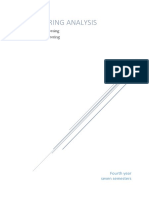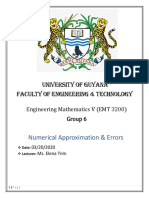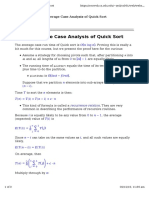Module 02 Lesson 02 - Fundamental Differentiation Formula For Algebraic Functions
Uploaded by
Kiziahlyn Fiona BibayModule 02 Lesson 02 - Fundamental Differentiation Formula For Algebraic Functions
Uploaded by
Kiziahlyn Fiona BibayCOURSE PACK
ESM 1030 – Engineering Calculus 1 (Differential
Calculus)
Module 02 : Derivatives of Algebraic and Transcendental Functions
Lesson 02 : Fundamental Differentiation Formula for Algebraic Functions
Week :4
STUDENT LEARNING OUTCOME
At the end of the session, students are able to:
1. Be familiar with the different notations for derivatives.
2. Evaluate the first derivative of a given algebraic function using the fundamental differentiation formula.
PRE-LECTIO
A. Homework
1. Answer Problem Set 2.2.
B. Review
1. Review delta process
2. Recall basic algebraic operations:
a) Laws of Exponents
b) Operations on Polynomials
c) Operations on Rational Expressions
d) Operations on Radical Expressions and Rationalization
LECTIO
Limitations of Delta Process
Evaluating the derivative of the function 𝑦 = 𝑓(𝑥), as previously stated, can be done by using Delta
Process. As a review, differentiation by delta process involves the formula:
𝑑𝑦 𝑓(𝑥 + ∆𝑥) − 𝑓(𝑥)
𝑦′ = = lim
𝑑𝑥 ∆𝑥→0 ∆𝑥
However, Delta Process has its limitations. For one, it is not the feasible option anymore when it comes to
complicated functions. Another is that the overall process is time-consuming, draining and tedious even for simple
polynomial or rational functions. To simplify this problem, we only need to be familiar with a few standard formulas
called the Differentiation Formula or Differentiation Rules. Applying the said rules will enable us to find the
derivative of both simple and complicated functions as rapidly as we can write.
Prepared by: Engr. Nelson John M. Namuag 1
Engineering Sciences and Mathematics Department
School of Engineering and Architecture
Ateneo de Davao University
COURSE PACK
ESM 1030 – Engineering Calculus 1 (Differential
Calculus)
All differentiation formula that you will encounter as you go through the course are standard formulas
whose derivations are done using delta process. Before we formally start our discussion on differentiation formula,
it is necessary for you to be familiar with the different notations for derivatives.
Traditionally, the Newton Notation was used to denote derivatives. But most calculus books today make
𝑑𝑦
use of either the Leibniz Notation or the Lagrange Notation. The symbol 𝑑𝑥 is read as “the derivative of 𝑦 with
respect to 𝑥”, 𝑦′ is read as “𝑦 prime”, and 𝑓′(𝑥) is read as “𝑓 prime of 𝑥”. As a student, you should be aware that
𝑑𝑦
the Leibniz Notation 𝑑𝑥 is not an absolute symbol for ALL derivatives. It varies from function to function. Say you
𝑑𝑦
are given the function 𝑠 = 𝑓(𝑡). Solving for the derivative does not mean you are solving for , rather you are
𝑑𝑥
𝑑𝑠
getting 𝑑𝑡
. The same goes for the function 𝑟 = 𝑓(𝜃), where the derivative in Leibniz Notation should be written as
𝑑𝑟
.
𝑑𝜃
Prepared by: Engr. Nelson John M. Namuag 2
Engineering Sciences and Mathematics Department
School of Engineering and Architecture
Ateneo de Davao University
COURSE PACK
ESM 1030 – Engineering Calculus 1 (Differential
Calculus)
Fundamental Differentiation Formula for Algebraic Functions
Now that we are acquainted with the many ways we can denote derivatives, let us learn the different fundamental
differentiation formula that we will find useful in the entire duration of the course.
Note: Rules #8 and #9 can be derived from Rule #7
Sample Problems: Solve for the first derivative of the following functions
1. 𝑦 = 𝑥 3 − 4𝑥 2 + 5
Solution: Using the sum rule and the power rule
𝑑 𝑑 3
(𝑦) = (𝑥 − 4𝑥 2 + 5)
𝑑𝑥 𝑑𝑥
𝑑𝑦 𝑑 3 𝑑 𝑑 Rule #4 from the list of differentiation rules can be thought of “the
= (𝑥 ) − (4𝑥 2 ) + (5) derivative of a sum is equal to the sum of the individual derivatives
𝑑𝑥 𝑑𝑥 𝑑𝑥 𝑑𝑥
𝑑𝑦 𝑑 𝑑 of each function”
= 3𝑥 3−1 (𝑥) − 4 (𝑥 2 ) + 0
𝑑𝑥 𝑑𝑥 𝑑𝑥
𝑑𝑦 2 (1) 2−1
𝑑
= 3𝑥 − 4(2)𝑥 (𝑥)
𝑑𝑥 𝑑𝑥
𝑑𝑦
= 3𝑥 2 − 8𝑥
𝑑𝑥
Prepared by: Engr. Nelson John M. Namuag 3
Engineering Sciences and Mathematics Department
School of Engineering and Architecture
Ateneo de Davao University
COURSE PACK
ESM 1030 – Engineering Calculus 1 (Differential
Calculus)
2. 𝑦 = √3𝑥 + 2
There are two (2) ways in which we can solve problem # 2. From the list of differentiation formula,
there is already an available rule for a square root function. This shall be the first method. For us to
determine how we will apply the second method, let us try to rewrite the given function in rational
exponent form.
1
𝑦 = √3𝑥 + 2 = (3𝑥 + 2)2
For the function that we have just obtained, we see that the term involves a POWER. Hence, our
second method will involve using the general power formula.
Solution: 1st method, applying the square root function rule
𝑑 1 𝑑𝑢
(√𝑢) = Differentiation Formula for Square Root
𝑑𝑥 2√𝑢 𝑑𝑥 Function
𝑑 𝑑
(𝑦) = (√3𝑥 + 2)
𝑑𝑥 𝑑𝑥
𝑑𝑦 1 𝑑 Differentiation, similar to basic operations such as addition and
= (3𝑥 + 2)
𝑑𝑥 2√3𝑥 + 2 𝑑𝑥 multiplication, follows properties of equality. In other words,
𝑑𝑦 1 when you attempt to differentiate an equation, you must do it to
= (3) both sides.
𝑑𝑥 2√3𝑥 + 2
𝑑𝑦 3 √3𝑥 + 2
= ∙
𝑑𝑥 2√3𝑥 + 2 √3𝑥 + 2
𝑑𝑦 3√3𝑥 + 2
=
𝑑𝑥 2(3𝑥 + 2)
Solution: 2nd method, applying the power rule
𝑑 𝑛 𝑑𝑢
(𝑢 ) = 𝑛𝑢𝑛−1 The Power Rule
𝑑𝑥 𝑑𝑥
𝑑𝑦 1 1 𝑑
= (3𝑥 + 2)2−1 (3𝑥 + 2)
𝑑𝑥 2 𝑑𝑥
𝑑𝑦 1 1
= (3𝑥 + 2)−2 (3)
𝑑𝑥 2 Recall from Laws of Exponents that exponential expressions with
𝑑𝑦 3 3
= = negative exponents should be written as one with positive exponents
𝑑𝑥 2(3𝑥 + 2)1⁄2 2√3𝑥 + 2 by getting the reciprocal
𝑑𝑦 3√3𝑥 + 2
=
𝑑𝑥 2(3𝑥 + 2)
Prepared by: Engr. Nelson John M. Namuag 4
Engineering Sciences and Mathematics Department
School of Engineering and Architecture
Ateneo de Davao University
COURSE PACK
ESM 1030 – Engineering Calculus 1 (Differential
Calculus)
3. 𝑦 = (3𝑡 3 − 2𝑡)2
Before we solve, notice that the given function is written in the form 𝑦 = 𝑓(𝑡). Therefore, the proper
𝑑𝑦 𝑑𝑦
way to denote its first derivative is 𝑑𝑡 and not 𝑑𝑥.
Solution: Using the power rule
𝑑𝑦 𝑑
= 2(3𝑡 3 − 2𝑡) (3𝑡 3 − 2𝑡) Common mistakes of students when using the power formula is that
𝑑𝑡 𝑑𝑡 𝑑𝑢 𝑑 𝑑𝑢
𝑑𝑦 they forget the part in the formula (𝑢𝑛 ) = 𝑛𝑢 𝑛−1
= 2(3𝑡 3 − 2𝑡)[3(3)𝑡 3−1 − 2𝑡] 𝑑𝑥 𝑑𝑥 𝑑𝑥
𝑑𝑡
𝑑𝑦
= 2(3𝑡 3 − 2𝑡)(9𝑡 2 − 2)
𝑑𝑡
4. 𝑦 = (2𝑥 + 1)3 (4𝑥 − 1)2
Solution: Using a combination of product rule and power rule
It can be seen in the function that we are given a product of two functions, each of which are raised to
a certain exponent. From the list of differentiation formula, the product rule has the form:
𝑑 𝑑𝑣 𝑑𝑢 The Product Rule
(𝑢𝑣) = 𝑢 +𝑣
𝑑𝑥 𝑑𝑥 𝑑𝑥
To solve for the first derivative of the given function, it is convenient to primarily assign the variables
𝑢 and 𝑣 to each factor present in the function. In this case we shall let 𝑢 = (2𝑥 + 1)3 and 𝑣 = (4𝑥 − 1)2 .
Once we have defined our variables 𝑢 and 𝑣, we are now ready to write the derivative of the function
as reflected on the right side of the product rule shown above.
𝑑𝑦 𝑑 𝑑
= (2𝑥 + 1)3 (4𝑥 − 1)2 + (4𝑥 − 1)2 (2𝑥 + 1)3
𝑑𝑥 𝑑𝑥 𝑑𝑥
𝑑𝑦 𝑑 𝑑
= (2𝑥 + 1)3 (2)(4𝑥 − 1) (4𝑥 − 1) + (4𝑥 − 1)2 (3)(2𝑥 + 1)2 (2𝑥 + 1)
𝑑𝑥 𝑑𝑥 𝑑𝑥
𝑑𝑦
= (2𝑥 + 1)3 (2)(4𝑥 − 1)(4) + (4𝑥 − 1)2 (3)(2𝑥 + 1)2 (2)
𝑑𝑥
𝑑𝑦
= 2(4𝑥 − 1)(2𝑥 + 1)2 [4(2𝑥 + 1) + 3(4𝑥 − 1)]
𝑑𝑥
𝑑𝑦
= 2(4𝑥 − 1)(2𝑥 + 1)2 (8𝑥 + 4 + 12𝑥 − 3)
𝑑𝑥
𝑑𝑦
= 2(4𝑥 − 1)(2𝑥 + 1)2 (20𝑥 + 1) Writing final answers in factored form especially when using both
𝑑𝑥 product and quotient rules of differentiation is recommended. If
possible, try to avoid expansion of powers too much.
Prepared by: Engr. Nelson John M. Namuag 5
Engineering Sciences and Mathematics Department
School of Engineering and Architecture
Ateneo de Davao University
COURSE PACK
ESM 1030 – Engineering Calculus 1 (Differential
Calculus)
(𝑥+1)3
5. 𝑦 = 𝑥2
Solution: Using a combination of quotient and power rules
Let us recall the differentiation formula for a quotient.
𝑑𝑢 𝑑𝑣
𝑑 𝑢 𝑣 −𝑢
( )= 𝑑𝑥 𝑑𝑥 The Quotient Rule
𝑑𝑥 𝑣 𝑣2
Similar to what was done in Problem #4, to easily use the quotient rule, we have to assign the
variables 𝑢 and 𝑣 first. In this case, 𝑢 = (𝑥 + 1)3 and 𝑣 = 𝑥 2 , for after which, we will immediately
substitute into the formula.
𝑑 𝑑 2
𝑥2 (𝑥 + 1)3 − (𝑥 + 1)3 (𝑥 )
′
𝑦 = 𝑑𝑥 𝑑𝑥
(𝑥 2 )2
𝑑
𝑥 2 (3)(𝑥 + 1)2 (𝑥 + 1) − (𝑥 + 1)3 (2𝑥)
′
𝑦 = 𝑑𝑥
𝑥4
2 (3)(𝑥 2
′
𝑥 + 1) − (𝑥 + 1)3 (2𝑥)
𝑦 = The quotient rule, unlike the product rule, has terms that are
𝑥4 uninterchangeable due to the subtraction operation. If you are having
2 [3𝑥
′
𝑥(𝑥 + 1) − 2(𝑥 + 1)] trouble memorizing the form of quotient rule, just follow “LOW D
𝑦 =
𝑥4 HIGH MINUS HIGH D LOW OVER LOW SQUARED”
(𝑥 2 (3𝑥
+ 1) − 2𝑥 − 2)
𝑦′ =
𝑥3
2
(𝑥 + 1) (𝑥 − 2) A primary advantage of writing answers in factored form, especially
𝑦′ =
𝑥3 for rational expressions is that we can cancel out common terms.
REFLECTION
To evaluate the derivative of a function, what are some of the things you need to remember?
Prepared by: Engr. Nelson John M. Namuag 6
Engineering Sciences and Mathematics Department
School of Engineering and Architecture
Ateneo de Davao University
COURSE PACK
ESM 1030 – Engineering Calculus 1 (Differential
Calculus)
EVALUATION
PROBLEM SET 2.2
Solve the first derivative of the following functions:
1. 𝑢 = (3𝑣 + 1)3 (2𝑣 − 3)4
2
(𝑥 2 −1)
2. 𝑦 =
𝑥 2 +1
3. 𝑦 = 𝑥(𝑎 − 𝑥 2 )3⁄2
2
4. 𝑓(𝑥) = √1 + √1 − 𝑥
Answers
𝑑𝑢
1. = (3𝑣 + 1)2 (2𝑣 − 3)3 (42𝑣 − 19)
𝑑𝑣
𝑑𝑦 2𝑥(𝑥−1)(𝑥+1)(𝑥 2 +3)
2. = (𝑥 2 +1)2
𝑑𝑥
𝑑𝑦
3. = (𝑎 − 2𝑥)(𝑎 + 2𝑥)√𝑎2 − 𝑥 2
𝑑𝑥
1
4. 𝑓 ′ (𝑥) = −
4√1−𝑥√1+√1−𝑥
Prepared by: Engr. Nelson John M. Namuag 7
Engineering Sciences and Mathematics Department
School of Engineering and Architecture
Ateneo de Davao University
COURSE PACK
ESM 1030 – Engineering Calculus 1 (Differential
Calculus)
REFERENCES
Calculus, 9th Edition, Ron Larson, Bruce H. Edwards
Differential and Integral Calculus, 6th Edition, Clyde E. Love, Earl D. Rainville
Prepared by: Engr. Nelson John M. Namuag 8
Engineering Sciences and Mathematics Department
School of Engineering and Architecture
Ateneo de Davao University
You might also like
- Evaluation and Operations involving Functions.2No ratings yetEvaluation and Operations involving Functions.28 pages
- Review of Algebra and Trigonometry: Pamantasan NG CabuyaoNo ratings yetReview of Algebra and Trigonometry: Pamantasan NG Cabuyao16 pages
- Lesson 1.a - 1.c - Integration Concepts & FormulasNo ratings yetLesson 1.a - 1.c - Integration Concepts & Formulas5 pages
- QUARTER - 3 - / SEMESTER - 2nd - Week 7No ratings yetQUARTER - 3 - / SEMESTER - 2nd - Week 710 pages
- 2. Differentiation of Complex FunctionsNo ratings yet2. Differentiation of Complex Functions32 pages
- Engineering Analysis: Faculty of Engineering Petroleum EngineeringNo ratings yetEngineering Analysis: Faculty of Engineering Petroleum Engineering7 pages
- Engineering Analysis: Faculty of Engineering Petroleum EngineeringNo ratings yetEngineering Analysis: Faculty of Engineering Petroleum Engineering7 pages
- Emt 3200 - Group 6 - Numerical Approximations & Errors - Report100% (1)Emt 3200 - Group 6 - Numerical Approximations & Errors - Report24 pages
- Module 3- Ordinary Differential Equations (1)No ratings yetModule 3- Ordinary Differential Equations (1)86 pages
- Differential equations of first order-1No ratings yetDifferential equations of first order-119 pages
- Differential EquationsLinaresFINALNAJUDNo ratings yetDifferential EquationsLinaresFINALNAJUD27 pages
- Mathematics For Engineering Differentiation Tutorial 1 - Basic DifferentiationNo ratings yetMathematics For Engineering Differentiation Tutorial 1 - Basic Differentiation12 pages
- Lecture-8 - 1-REVIEW OF DIFFERENTIATION TECHNIQUESNo ratings yetLecture-8 - 1-REVIEW OF DIFFERENTIATION TECHNIQUES6 pages
- Basic Calculus 3rd Quarter Week 8 MergedNo ratings yetBasic Calculus 3rd Quarter Week 8 Merged11 pages
- SLG 2.1.2 Definition of Functions and Operations On Functions (Session 2 of 3)No ratings yetSLG 2.1.2 Definition of Functions and Operations On Functions (Session 2 of 3)6 pages
- Chapter 1 - 1st Order Differential Equation - Part 1No ratings yetChapter 1 - 1st Order Differential Equation - Part 157 pages
- Module 3 Unit III the Definite IntegralNo ratings yetModule 3 Unit III the Definite Integral19 pages
- QA Basic Calculus Quarter 3 Week 4 FinalNo ratings yetQA Basic Calculus Quarter 3 Week 4 Final12 pages
- 5.3 Differentiating Implicit Functions Containing Products and QuotientsNo ratings yet5.3 Differentiating Implicit Functions Containing Products and Quotients4 pages
- Calculus II - Integral Calculus: //based From The CMO/PSG of The Program It Maybe Per Topic or Per ModuleNo ratings yetCalculus II - Integral Calculus: //based From The CMO/PSG of The Program It Maybe Per Topic or Per Module7 pages
- Mathematics 1St First Order Linear Differential Equations 2Nd Second Order Linear Differential Equations Laplace Fourier Bessel MathematicsFrom EverandMathematics 1St First Order Linear Differential Equations 2Nd Second Order Linear Differential Equations Laplace Fourier Bessel MathematicsNo ratings yet
- 4.sample Literary Essay - Eleven - by Sandra CisnerosbdocxNo ratings yet4.sample Literary Essay - Eleven - by Sandra Cisnerosbdocx1 page
- Module 02 Lesson 01 - The Derivative (Rates of Change and Delta Process)No ratings yetModule 02 Lesson 01 - The Derivative (Rates of Change and Delta Process)12 pages
- M5-2 CE 2131 Closed Traverse - Interior Angles V2021No ratings yetM5-2 CE 2131 Closed Traverse - Interior Angles V202119 pages
- Module 02 Lesson 03 - Derivatives of Trigonometric Functions (With Limits)No ratings yetModule 02 Lesson 03 - Derivatives of Trigonometric Functions (With Limits)16 pages
- A3 Practice Problems in ERRORS AND MISTAKES S1No ratings yetA3 Practice Problems in ERRORS AND MISTAKES S11 page
- Kiziahlyn Fiona B. Bibay Bsce 2-A Assignment#5 Problem 1 GivenNo ratings yetKiziahlyn Fiona B. Bibay Bsce 2-A Assignment#5 Problem 1 Given3 pages
- On Generalization Property of Is - Open Sets in Ideal Topological SemigroupsNo ratings yetOn Generalization Property of Is - Open Sets in Ideal Topological Semigroups5 pages
- C# OOP Basics Exam Preparation II - Avatar Stage I: Create Class HierarchyNo ratings yetC# OOP Basics Exam Preparation II - Avatar Stage I: Create Class Hierarchy12 pages
- Ib Math HL Differentiation Past Exam QuestionNo ratings yetIb Math HL Differentiation Past Exam Question19 pages
- Numerical Methods for Engineers 6th Edition Chapra Solutions Manual - Free Download Available To Read All ChaptersNo ratings yetNumerical Methods for Engineers 6th Edition Chapra Solutions Manual - Free Download Available To Read All Chapters69 pages
- Continuous RV Probability DistributionsNo ratings yetContinuous RV Probability Distributions51 pages
- Analysis of Differential Calculus in EconomicsNo ratings yetAnalysis of Differential Calculus in Economics7 pages
- Tugasan Kumpulan Set A SM025 Soalan 2019 - 2020 PDFNo ratings yetTugasan Kumpulan Set A SM025 Soalan 2019 - 2020 PDF6 pages
- Review of Algebra and Trigonometry: Pamantasan NG CabuyaoReview of Algebra and Trigonometry: Pamantasan NG Cabuyao
- Lesson 1.a - 1.c - Integration Concepts & FormulasLesson 1.a - 1.c - Integration Concepts & Formulas
- Engineering Analysis: Faculty of Engineering Petroleum EngineeringEngineering Analysis: Faculty of Engineering Petroleum Engineering
- Engineering Analysis: Faculty of Engineering Petroleum EngineeringEngineering Analysis: Faculty of Engineering Petroleum Engineering
- Emt 3200 - Group 6 - Numerical Approximations & Errors - ReportEmt 3200 - Group 6 - Numerical Approximations & Errors - Report
- Mathematics For Engineering Differentiation Tutorial 1 - Basic DifferentiationMathematics For Engineering Differentiation Tutorial 1 - Basic Differentiation
- Lecture-8 - 1-REVIEW OF DIFFERENTIATION TECHNIQUESLecture-8 - 1-REVIEW OF DIFFERENTIATION TECHNIQUES
- SLG 2.1.2 Definition of Functions and Operations On Functions (Session 2 of 3)SLG 2.1.2 Definition of Functions and Operations On Functions (Session 2 of 3)
- Chapter 1 - 1st Order Differential Equation - Part 1Chapter 1 - 1st Order Differential Equation - Part 1
- 5.3 Differentiating Implicit Functions Containing Products and Quotients5.3 Differentiating Implicit Functions Containing Products and Quotients
- Calculus II - Integral Calculus: //based From The CMO/PSG of The Program It Maybe Per Topic or Per ModuleCalculus II - Integral Calculus: //based From The CMO/PSG of The Program It Maybe Per Topic or Per Module
- Mathematics 1St First Order Linear Differential Equations 2Nd Second Order Linear Differential Equations Laplace Fourier Bessel MathematicsFrom EverandMathematics 1St First Order Linear Differential Equations 2Nd Second Order Linear Differential Equations Laplace Fourier Bessel Mathematics
- 4.sample Literary Essay - Eleven - by Sandra Cisnerosbdocx4.sample Literary Essay - Eleven - by Sandra Cisnerosbdocx
- Module 02 Lesson 01 - The Derivative (Rates of Change and Delta Process)Module 02 Lesson 01 - The Derivative (Rates of Change and Delta Process)
- M5-2 CE 2131 Closed Traverse - Interior Angles V2021M5-2 CE 2131 Closed Traverse - Interior Angles V2021
- Module 02 Lesson 03 - Derivatives of Trigonometric Functions (With Limits)Module 02 Lesson 03 - Derivatives of Trigonometric Functions (With Limits)
- Kiziahlyn Fiona B. Bibay Bsce 2-A Assignment#5 Problem 1 GivenKiziahlyn Fiona B. Bibay Bsce 2-A Assignment#5 Problem 1 Given
- On Generalization Property of Is - Open Sets in Ideal Topological SemigroupsOn Generalization Property of Is - Open Sets in Ideal Topological Semigroups
- C# OOP Basics Exam Preparation II - Avatar Stage I: Create Class HierarchyC# OOP Basics Exam Preparation II - Avatar Stage I: Create Class Hierarchy
- Numerical Methods for Engineers 6th Edition Chapra Solutions Manual - Free Download Available To Read All ChaptersNumerical Methods for Engineers 6th Edition Chapra Solutions Manual - Free Download Available To Read All Chapters
- Tugasan Kumpulan Set A SM025 Soalan 2019 - 2020 PDFTugasan Kumpulan Set A SM025 Soalan 2019 - 2020 PDF
































































































